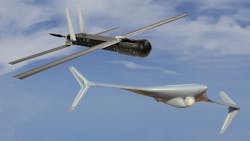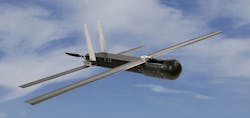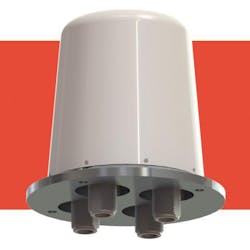EW Systems Form Fit to UAS Requirements
Members can download this article in PDF format.
What you’ll learn:
- Multifunction systems are the future of electronic warfare.
- Smaller, lighter EW systems will enable next-generation UAVs.
- Cyber is the latest front in the ongoing evolution of EW.
Electronic-warfare (EW) systems play important roles on the modern battlefield, on land, at sea, and in the air—including outer space. By virtue of U.S. Department of Defense (DoD) requirements for smaller size, weight, and power (SWaP), what were once rooms filled with racks of equipment are being shrunk to mobile, portable systems that must stand up to rough treatment under harsh operating conditions.
In recent years, EW system designers have counted on RF/microwave component and subsystem suppliers for smaller, lighter hardware to keep pace with customer demands for more electronic functions in smaller spaces. They’re also faced with EW systems handling more data from more sensors, requiring wider operating bandwidths that push into the millimeter-wave (mmWave) frequency range to handle the huge amounts of data at faster transfer rates. The emergence of 5G cellular wireless networks may aid both commercial and military users.
EW system design has long been about maintaining an advantage over an adversary, to track their weapons systems and develop responses to stop them. Most EW systems provide a combination of functions based on electronic-attack (EA) and electronic-support (ES) modes, processing large amounts of data from their antennas and multiple sensors. EW receivers must be capable of detecting and identifying potential threat signals.
Electronic-countermeasures (ECM) systems must block an adversary’s attempts at communication and transmit false signals. These include radar signals that imitate what might be the reflected return signals from a large airborne fighting force.
Various forms of EW detection and response systems have traditionally been designed and constructed as discrete systems typically for specific operating domains, such as air, sea, or land. But pressures to equip modern mobile fighting forces with smaller, lighter, and more capable EW systems are driving higher levels of EW integration. It’s even reached the point of building single-system platforms that can provide EW, ECM, communications, and radar functions within a form factor that once supplied only one of the functions.
Although multifunction military electronic systems have been in development for more than 50 years, SWaP requirements are now pressuring system designers to achieve much smaller footprints. Expansion of EW systems beyond the traditional frequency range of 2 to 18 GHz provides EW system designers with additional bandwidth at mmWave frequencies. However, it makes circuit fabrication more difficult as linewidths and spacings shrink with increasing frequencies.
The signal-processing requirements for multifunction systems are more complex than for single-function systems, too. Greater computing power is required in a resource allocation manager (RAM) to coordinate the use of a combination system’s different capabilities, such as radar signal detection and signal generation for jamming in response.
Start with the Antenna
Low-profile antennas are essential components for multifunction EW systems. Advances in active electronically scanned array (AESA) antennas and their supporting integrated circuits (ICs) have made possible smaller multifunction military electronic systems capable of transmitting and receiving signals for EW, radar, and communications. AESAs use multiple antenna elements in conjunction with multiple transmit/receive modules (TRMs) to form and steer beams electronically, without physical movement of an antenna.
To achieve an antenna with a low profile, the antenna ICs, such as beamsteering ICs, are mounted on the same plane as the antenna elements. However, this design approach becomes more challenging at higher frequencies, such as mmWave frequencies, because the spacing between antenna elements becomes tighter with increasing frequency, degrading the isolation between antenna elements.
AESAs have become the antenna of choice for many air-to-air and air-to-ground radar systems on high-speed aircraft like the F-35 fighter jet. The electronic tuning and control of these antennas also makes them viable choices for multifunction EW systems covering wide surveillance ranges, as well as for providing reception of radar signals and high-speed data communications.
As system designs move to higher levels of integration, employing multiple system-in-package (SiP) devices to enable multiple EW functions within compact modules, EW and other military electronic systems are relying on modular architectures for flexibility. Modular design approaches simplify system upgrades and help speed the production of complex systems. The growing density of ICs supports SWaP goals, as IC designers look at a single device where once there were many, such as field-programmable gate arrays (FPGAs) with analog-to-digital converters (ADCs) and digital-to-analog converters (DACs) within the same package.
Modern EW systems rely on many distributed sensors to capture details about an opponent’s capabilities, e.g., sensors using radar signals or infrared (IR) energy for threat detection and targeting purposes. As EW systems grow in complexity, gathering data from increasing numbers of sensors on manned and unmanned systems, EW system designers are faced with processing more data at higher speeds, to minimize latency and enable an instantaneous response to a threat. In addition, data interoperability (DI) among various EW and other military electronic systems is essential for different branches of the armed forces to seamlessly work together.
Automated Pilots
Growing use of unmanned aerial systems (UAS) with EW and ECM capabilities drives the need for smaller, lighter EW systems as payloads. UAS equipment is being developed for all military branches for single-use (expendable) and multiple-use (survivable) missions, including surveillance, signal intelligence (SIGINT), and carrying munitions to a target.
Two such examples are the Coyote UAS (Fig. 1) from Raytheon Technologies, which is part of the U.S. Navy’s Low-Cost UAV Swarming Technology (LOCUST) program, and the compact Fire Shadow UAS from Lockheed Martin that’s been used for loitering munitions missions. Low-cost Coyote drones can fly in highly coordinated swarms of thousands under the control of a single computer. The flight paths of all those many drones are closely mapped so that they can appear as a single flying vehicle while collecting data with separate sensors.
The U.S. Navy has also worked with Lockheed Martin on the Outrider UAS (Fig. 2), which can be launched from canisters that fit inside submarine missile tubes. The small drones are part of the work done by the Naval Research Laboratory (NRL) on all-electric drones with folding wings. They can launch from torpedo tubes but are also robust enough to carry numerous sensor payloads, including electromagnetic (EM), electro-optical (EO), and infrared (IR) sensors for intelligence, surveillance, and reconnaissance (ISR) missions.
Somewhat larger, the “Bat” family of UAS aircraft includes vehicles with 12- and 14-ft. wingspans (Fig. 3). Flown by means of an IP-based ground control station, the Bat UAS drones have deployed a variety of payloads, including EW and aerial intelligence, surveillance, and reconnaissance (AISR) systems.
Rather than AESA antennas, many UAS drones employ multiple-input, multiple-output (MIMO) antennas for medium-range communications with command stations and other UAS EW systems. For applications that require it, MIMO antennas (Fig. 4) are capable of higher transmit power levels than AESA antennas and are rugged enough to survive air speeds more than 350 mph. They also can be designed to meet the SWaP requirements of medium-sized aircraft.
These few examples represent the growing numbers of UAS applications and their EM, EO, and IR sensors at work in the battlespace to provide full-motion videos and data related to battlefield conditions. On top of that, the U.S. Army is pursuing UAS capabilities including AISR platforms that remain competitive during multidomain operations (MDOs) on land, sea, and in the air. This includes a multilayered approach with sensors on unmanned platforms as part of very-low-altitude, very-high-altitude, and low-Earth-orbit satellite (LEOS) systems.
With its recent launch of two CubeSat nanosatellites into low Earth orbit, the U.S. Missile Defense Agency (MDA) is establishing the foundation for a CubeSat-based missile defense system. The MDA is planning for low latency in communications between sensors on CubeSats, LEOS, drones, and missile defense systems for full EW coverage and protection against missile attacks.
Still, the large amounts of data produced by thousands of drones and their sensors poses new challenges for EW system designers in maintaining data integrity, cybersecurity, and high reliability under signal-congested and environmentally changing operating conditions.
While EW sensors on land, at sea, in the air, and in space continue to generate data, modern EW systems will be tasked with converting massive amounts of sensor data into usable command, control, and communications (C3) information. The use of technologies such as artificial intelligence (AI) and machine learning (ML) backed by more powerful digital-signal-processing (DSP) power can help to organize large amounts of real-time data. In addition, this data must be usable among the different branches of the armed forces and among any joint forces like the North Atlantic Treaty Organization’s (NATO) troops.
Such DI is more easily achieved when EW systems are designed as open system architectures rather than proprietary system designs. When data is controlled and defined according to standards established by industry organizations, such as the Sensor Open Systems Architecture (SOSA) or the Modular Open Systems Approach (MOSA), data from multiple sensors can be more freely and accurately shared by multiple systems and users. A modular systems architecture simplifies upgrades and the addition of new functions to an EW system while helping reduce costs.
Keep It Safe
Modern EW data management involves maintaining the integrity and security of sensor data via a form of EW now known as “cyber EW.” Major contractors have developed systems in response to the many forms of an adversary’s cyber warfare, such as malware intrusions and distributed denial of service. For example, Lockheed Martin’s Spectrum Convergence systems are integrated defensive approaches to safeguarding information within networked infrastructures against intrusion.
Effective cyber-EW systems also can be used to gather intelligence on an intruding adversary. “Silent CROW” is an example of a cyber-EW system that can be configured for ground and airborne systems, including on wing-mounted pods for UAS applications.
Deon Viergutz, vice-president of Spectrum Convergence at Lockheed Martin, says, “Silent CROW is the next evolution of our cyber-EW systems. It’s a great example of the type of new technologies we’re focusing on—scalable, affordable, and designed to help our DoD customers overcome advances in adversary technologies to effectively support warfighters in joint, all-domain operations.”
By investing in internal R&D, Lockheed Martin is applying newer technologies like AI and machine-to-machine (M2M) communications to identify potential threats across the spectrum in real-time. The company’s support of open system architectures and standards such as SOSA have helped achieve DI and data protection against cyber threats.
Embedded Computing
Increased embedded computing power will play an important role in future EW systems, with distributed processing performed across an EW platform as much as possible to reduce the data workload from so many sensors. Integrated mixed-signal devices, e.g. FPGAs with integrated data converter, will make this practical.
In pursuit of such integrated computing power for EW applications, Lockheed Martin recently revealed support for a new technology from Intel Corp. that represents a major step toward fabricating a single component incorporating the functions of an FPGA, DAC, and ADC. Having achieved sampling rates to 64 Gsamples/s, such a technology would enable direct digitization of RF/microwave signals for markets including EW, radar, test and measurement, and 5G communications systems.
Frank Ferrante, director of Military Aerospace and Defense at Intel Corp., says, “This breakthrough technology offers more than 5X higher bandwidth than alternative offerings and supports ADC sample rates up to 64 Gsamples/s, which open new design possibilities for communications and high-end test-and-measurement applications. It also enables radar designers to architect their systems in a completely new way—reducing the number of analog components required and creating more responsive systems.”
The new FPGA technology was developed in part from research funded by the DARPA CHIPS program. Lockheed Martin was instrumental in co-defining critical requirements and use cases to make the technology mission ready. According to Deon Viergutz, “This technology allows us to integrate our latest-generation electronic-warfare systems into smaller airborne platforms and air-launched effects that were previously unattainable due to size constraints of the air vehicle. As a result, we’ve created the Ultra Small Affordable Electronic Warfare (USAEW) sensor that provides the 21st century warfighter advanced capabilities while substantially reducing the systems’ size, weight, power, and cost by an order of magnitude.”
Hold the Phone
Raytheon Intelligence & Space (RI&S) is exploring a networking approach to use 5G cellular wireless systems that provide secure data access for armed forces around the world. “The services must be able to share and access data at any time from any location,” says David Appel, vice-president of Defense & Civil Solutions for Space & C2 Systems for RI&S. “Being able to operate secure applications on 5G gives everyone up and down the command chain the ability to see the same thing at the same time. 5G networks provide the speed and resiliency needed to take the command center virtual, so no matter where you’re located, you know what’s going on around you.” With 5G networks available for real-time data transfers when needed, command responses will be quicker and more informed, based on as much in-field sensor data as possible.
According to Chris Worley, director for Defense & Civil Solutions at RI&S, “We can enhance applications to run on 5G, so even if you lose your connection or it’s spotty, the latest data is already downloaded. Operators will be able to access imagery and data faster for smarter mission decisions, mitigating the risk of casualties in close contact.”
The additional bandwidth at mmWave frequencies that helps commercial customers download files quickly will provide near instant data access for military users, at backplane speeds approaching 10 Gb/s.
About the Author
Jack Browne
Technical Contributor
Jack Browne, Technical Contributor, has worked in technical publishing for over 30 years. He managed the content and production of three technical journals while at the American Institute of Physics, including Medical Physics and the Journal of Vacuum Science & Technology. He has been a Publisher and Editor for Penton Media, started the firm’s Wireless Symposium & Exhibition trade show in 1993, and currently serves as Technical Contributor for that company's Microwaves & RF magazine. Browne, who holds a BS in Mathematics from City College of New York and BA degrees in English and Philosophy from Fordham University, is a member of the IEEE.




